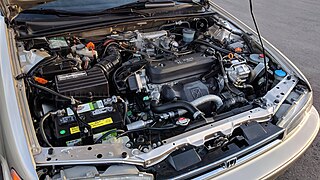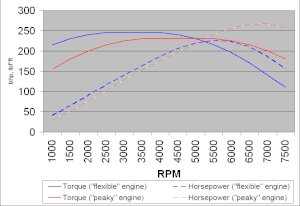
In an internal combustion engine, a turbocharger is a forced induction device that is powered by the flow of exhaust gases. It uses this energy to compress the intake air, forcing more air into the engine in order to produce more power for a given displacement.

In engineering, the Miller cycle is a thermodynamic cycle used in a type of internal combustion engine. The Miller cycle was patented by Ralph Miller, an American engineer, U.S. patent 2,817,322 dated Dec 24, 1957. The engine may be two- or four-stroke and may be run on diesel fuel, gases, or dual fuel. It uses a supercharger or a turbocharger to offset the performance loss of the Atkinson cycle.

A camshaft is a shaft that contains a row of pointed cams in order to convert rotational motion to reciprocating motion. Camshafts are used in piston engines, mechanically controlled ignition systems and early electric motor speed controllers.

MIVEC (Mitsubishi Innovative Valve timing Electronic Control system) is the brand name of a variable valve timing (VVT) engine technology developed by Mitsubishi Motors. MIVEC, as with other similar systems, varies the timing of the intake and exhaust camshafts which increases the power and torque output over a broad engine speed range while also being able to help spool a turbocharger more quickly and accurately.

Redline refers to the maximum engine speed at which an internal combustion engine or traction motor and its components are designed to operate without causing damage to the components themselves or other parts of the engine. The redline of an engine depends on various factors such as stroke, mass of the components, displacement, composition of components, and balance of components.

Mazda has a long history of building its own diesel engines, with the exception of a few units that were built under license.

Engine braking occurs when the retarding forces within an internal combustion engine are used to slow down a motor vehicle, as opposed to using additional external braking mechanisms such as friction brakes or magnetic brakes.

A traction motor is an electric motor used for propulsion of a vehicle, such as locomotives, electric or hydrogen vehicles, or electric multiple unit trains.
The anti-lag system (ALS) is a method of reducing turbo lag or effective compression used on turbocharged engines to minimize turbo lag on racing or performance cars. It works by delaying the ignition timing and adding extra fuel to balance an inherent loss in combustion efficiency with increased pressure at the charging side of the turbo. This is achieved as an excess amount of fuel/air mixture escapes through the exhaust valves and combusts in the hot exhaust manifold spooling the turbocharger creating higher usable pressure.

The Honda F-Series engine was considered Honda's "big block" SOHC inline four, though lower production DOHC versions of the F-series were built. It features a solid iron or aluminum open deck cast iron sleeved block and aluminum/magnesium cylinder head.
The two-stroke power valve system is an improvement to a conventional two-stroke engine that gives a high power output over a wider RPM range.
A camless or free-valve piston engine is an engine that has poppet valves operated by means of electromagnetic, hydraulic, or pneumatic actuators instead of conventional cams. Actuators can be used to both open and close valves, or to open valves closed by springs or other means.
A twincharger refers to a compound forced induction system used on some internal combustion engines. It is a combination of an exhaust-driven turbocharger and a mechanically driven supercharger, each mitigating the weaknesses of the other.

The mean piston speed is the average speed of the piston in a reciprocating engine. It is a function of stroke and RPM. There is a factor of 2 in the equation to account for one stroke to occur in 1/2 of a crank revolution and a '60' to convert seconds from minutes in the RPM term.

The Mitsubishi 4B1 engine is a range of all-alloy straight-4 piston engines built at Mitsubishi's Japanese "World Engine" powertrain plant in Shiga on the basis of the Global Engine Manufacturing Alliance (GEMA). Although the basic designs of the various engines are the same, their exact specifications are individually tailored for each partner. The cylinder block and other basic structural parts of the engine were jointly developed by the GEMA companies, but the intake and exhaust manifolds, the cylinder head's intake and exhaust ports, and other elements related to engine tuning were independently developed by Mitsubishi.
Hybrid vehicle drivetrains transmit power to the driving wheels for hybrid vehicles. A hybrid vehicle has multiple forms of motive power.
Short shifting is a driving technique in which the gear is changed up before reaching maximum engine RPM or, more precisely, the acceleration optimized RPM shift-point. By short shifting, the engine does not reach its power band, and therefore maximum vehicle acceleration is not attained for the gear from which the short shift was performed.
The Paxman Hi-Dyne engine was a form of experimental diesel engine developed for rail transport use by the British engine makers Paxman of Colchester. They used variable supercharging to give a constant power output across their speed range.

An internal combustion engine is a heat engine in which the combustion of a fuel occurs with an oxidizer in a combustion chamber that is an integral part of the working fluid flow circuit. In an internal combustion engine, the expansion of the high-temperature and high-pressure gases produced by combustion applies direct force to some component of the engine. The force is typically applied to pistons, turbine blades, a rotor, or a nozzle. This force moves the component over a distance, transforming chemical energy into kinetic energy which is used to propel, move or power whatever the engine is attached to.

An internal combustion locomotive is a type of railway locomotive that produces its pulling power using an internal combustion engine. These locomotives are fuelled by burning fossil fuels, most commonly oil or gasoline, to produce rotational power which is transmitted to the locomotive's driving wheels by various direct or indirect transmission mechanisms. The fuel is carried on the locomotive.













